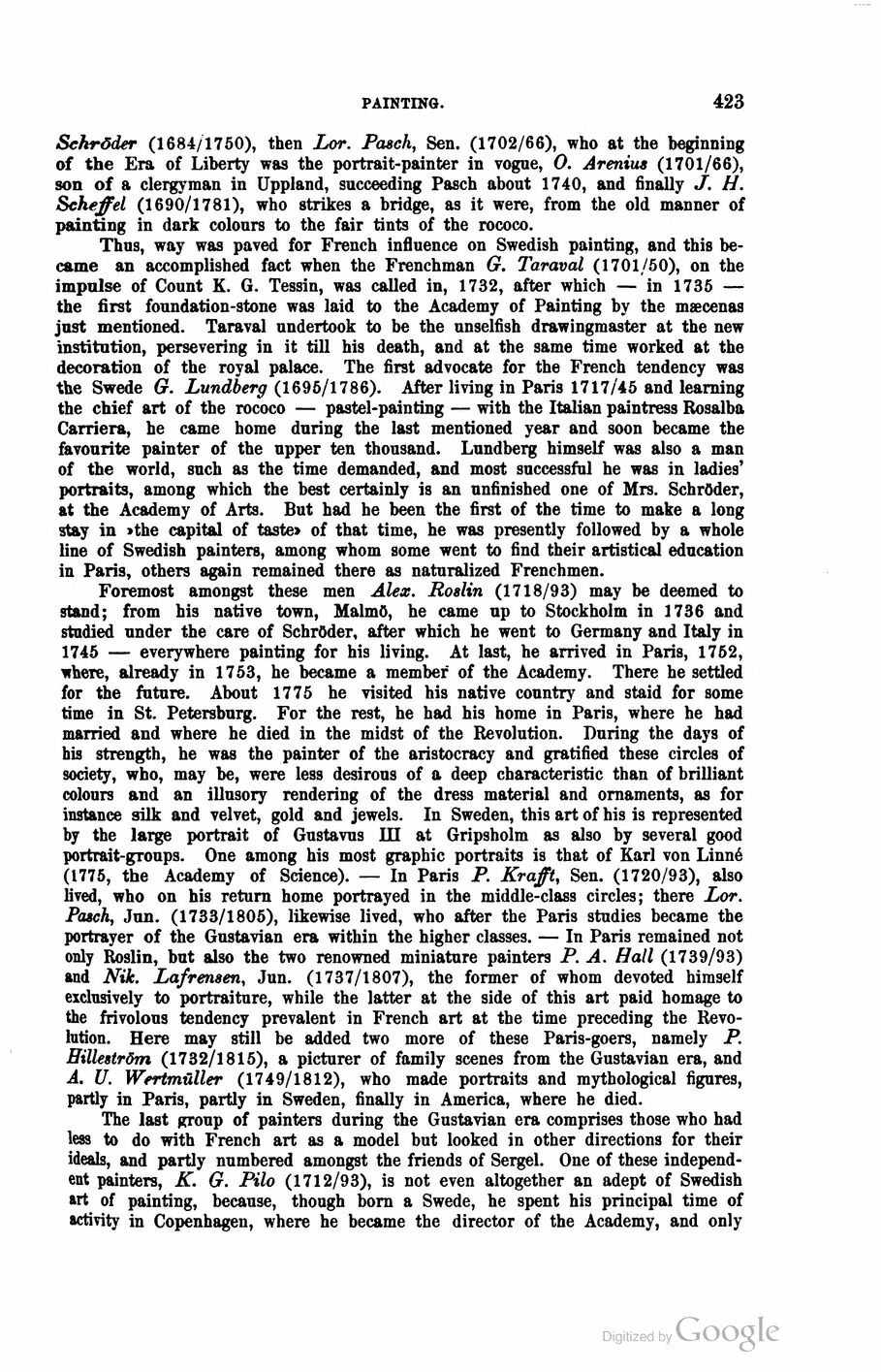
Full resolution (JPEG) - On this page / på denna sida - First part - IV. Education and Mental Culture - 9. The Fine Arts - Painting, by Prof. C. R. Nyblom, Ph. D., Stockholm

<< prev. page << föreg. sida << >> nästa sida >> next page >>
Below is the raw OCR text
from the above scanned image.
Do you see an error? Proofread the page now!
Här nedan syns maskintolkade texten från faksimilbilden ovan.
Ser du något fel? Korrekturläs sidan nu!
This page has never been proofread. / Denna sida har aldrig korrekturlästs.
PAINTING.
423
Schröder (1684/1750), then Lor. Pasch, Sen. (1702/66), who at the beginning
of the Era of Liberty was the portrait-painter in vogue, O. Arenius (1701/66),
son of a clergyman in Uppland, succeeding Pasch about 1740, and finally J. H.
Scheffel (1690/1781), who strikes a bridge, as it were, from the old manner of
painting in dark colours to the fair tints of the rococo.
Thus, way was paved for French influence on Swedish painting, and this
became an accomplished fact when the Frenchman G. Taraval (1701/50), on the
impulse of Count K. G. Tessin, was called in, 1732, after which — in 1735 —
the first foundation-stone was laid to the Academy of Painting by the maecenas
just mentioned. Taraval undertook to be the unselfish drawingmaster at the new
institution, persevering in it till his death, and at the same time worked at the
decoration of the roval palace. The first advocate for the French tendency was
the Swede G. Lundberg (1695/1786). After living in Paris 1717/45 and learning
the chief art of the rococo — pastel-painting — with the Italian paintress Rosalba
Camera, he came home during the last mentioned year and soon became the
favourite painter of the upper ten thousand. Lundberg himself was also a man
of the world, such as the time demanded, and most successful he was in ladies’
portraits, among which the best certainly is an unfinished one of Mrs. Schröder,
at the Academy of Arts. But had he been the first of the time to make a long
stay in »the capital of taste» of that time, he was presently followed by a whole
line of Swedish painters, among whom some went to find their artistical education
in Paris, others again remained there as naturalized Frenchmen.
Foremost amongst these men Alex. Roslin (1718/93) may be deemed to
stand; from his native town, Malmö, he came up to Stockholm in 1736 and
studied under the care of Schröder, after which he went to Germany and Italy in
1745 — everywhere painting for his living. At last, he arrived in Paris, 1752,
where, already in 1753, he became a member" of the Academy. There he settled
for the future. About 1775 he visited his native country and staid for some
time in St. Petersburg. For the rest, he had his home in Paris, where he had
married and where he died in the midst of the Revolution. During the days of
his strength, he was the painter of the aristocracy and gratified these circles of
society, who, may be, were less desirous of a deep characteristic than of brilliant
colours and an illusory rendering of the dress material and ornaments, as for
instance silk and velvet, gold and jewels. In Sweden, this art of his is represented
by the large portrait of Gustavus III at Gripsholm as also by several good
portrait-groups. One among his most graphic portraits is that of Karl von Linné
(1775, the Academy of Science). — In Paris P. Krafft, Sen. (1720/93), also
lived, who on his return home portrayed in the middle-class circles; there Lor.
Pasch, Jun. (1733/1805), likewise lived, who after the Paris studies became the
portrayer of the Gustavian era within the higher classes. — In Paris remained not
only Roslin, but also the two renowned miniature painters P. A. Hall (1739/93)
and Nik. Lafrensen, Jun. (1737/1807), the former of whom devoted himself
exclusively to portraiture, while the latter at the side of this art paid homage to
the frivolous tendency prevalent in French art at the time preceding the
Revolution. Here may still be added two more of these Paris-goers, namely P.
Hilleström (1732/1815), a picturer of family scenes from the Gustavian era, and
A. U. Wertmuller (1749/1812), who made portraits and mythological figures,
partly in Paris, partly in Sweden, finally in America, where he died.
The last group of painters during the Gustavian era comprises those who had
less to do with French art as a model but looked in other directions for their
ideals, and partly numbered amongst the friends of Sergei. One of these
independent painters, K. G. Pilo (1712/93), is not even altogether an adept of Swedish
art of painting, because, though born a Swede, he spent his principal time of
activity in Copenhagen, where he became the director of the Academy, and only
<< prev. page << föreg. sida << >> nästa sida >> next page >>